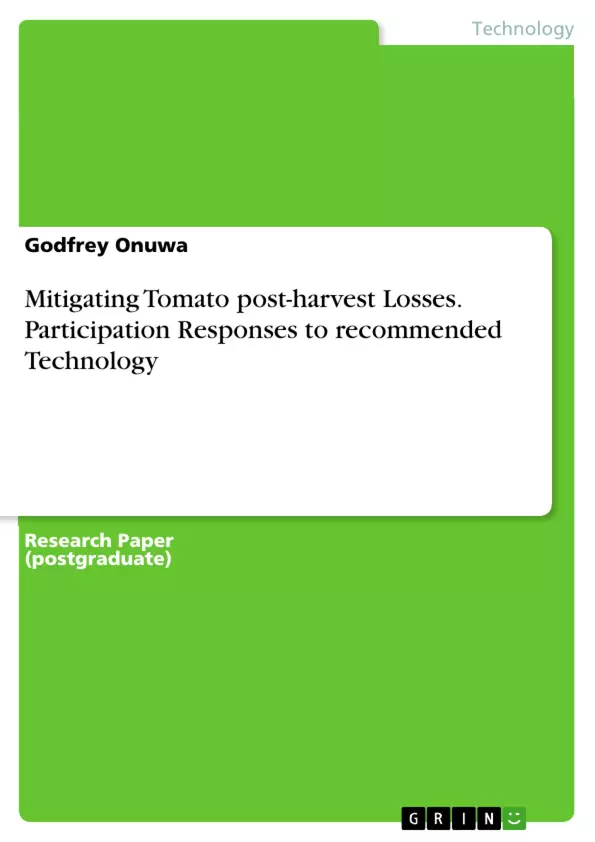This study investigated the economics of post-harvest losses among tomato farmers in Barkin-Ladi Local Government Area of Plateau State, Nigeria. Multi-stage sampling techniques were used in selecting respondents for this study. Primary data was collected using structured questionnaires. Descriptive statistics, Likert method and ordinary least square regression model; were analytical techniques employed. The result revealed that 62% of the respondents were males, 72% are married. The mean age was 42 years. Most (38%) attained primary education, 48% had a household size with population of 1-5 people. The mean year of experience was 17 years. Most (78%) used woven baskets in packaging their produce. The prevalent improved post-harvest techniques were; appropriate harvesting techniques (2.79), improved drying techniques (2.69) and improved processing technology (2.62) as indicated by their significant mean scores. The estimated value of tomato post-harvest loss per 50kg was 27.5%. Thus, estimated gross margin were ₦5,400 (without loss) and ₦3,910 (with loss) respectively. The coefficients of farming experience (-0.421), distance to markets (0.413), age of fruit at harvest (0.519), quantity of fruits harvested (0.387) and post-harvest practices (-0.396) were statistically significant at 5% level. The estimated coefficient of multiple determination (R2) was 0.795, suggesting that 79% of post-harvest losses were attributable to the variables in the regression model. The constraints identified affected tomato post-harvest loss reduction. Adoption of improved post-harvest techniques, storage and processing facilities, provision of improved market linkages and access to agricultural credit, extension contact and formation of producer cooperatives are strongly recommended for reduced wastages.
Inhaltsverzeichnis (Table of Contents)
- ABSTRACT
- CHAPTER ONE
- INTRODUCTION
- Background of the Study
- Problem statement
- Objectives of the study
- Hypothesis of the study
- Justification of the Study
- Scope of the Study
- CHAPTER TWO
- LITERATURE REVIEW
- Tomato as a Staple Fruit Vegetable
- Challenges Confronting Tomato Production in Nigeria
- Determinants of Post-Harvest Losses in Tomato
- Causes of Post-Harvesting Losses in Tomatoes
- On-Farm Causes of Post-Harvest Losses
- Off-Farm Causes of Post-harvest Tosses in Tomatoes
- Post-Harvest Strategies
- Challenges to Reducing Post-Harvest Losses
- CHAPTER THREE
- METHODOLOGY
- Study Area
- Sources of Data Collection
- Sample Size and Sampling Technique
- Analytical Techniques
- Model Specification
- Likert scale method
- Gross margin analysis
- Ordinary Least Square (OLS) regression Model
- CHAPTER FOUR
- RESULTS AND DISCUSSION
- Socioeconomic characteristics of the respondents
- Gender of respondents
- Age of the respondents
- Marital status of the respondents
- Educational level
- House hold size of respondents
- Years of experience
- Source of capital
- Extension Contact
- Mode of transportation
- Packaging materials used by the respondents
- Perception of improved post-harvest techniques
- Effect of post-harvest loss on farmers income
- Factors influencing tomato post-harvest losses
- Constraints to post-harvest loss reduction
- CHAPTER FIVE
- SUMMARY, CONCLUSION AND RECOMMENDATION
- Summary
- Conclusion
- Recommendation
- REFERENCE
Zielsetzung und Themenschwerpunkte (Objectives and Key Themes)
This study aims to understand the economic impact of post-harvest losses on tomato farmers in Barkin-Ladi Local Government Area of Plateau State, Nigeria. It investigates the factors contributing to these losses, the farmers' perceptions of improved post-harvest techniques, and the constraints they face in implementing such techniques.
- Economic impact of post-harvest losses on tomato farmers
- Factors influencing tomato post-harvest losses
- Farmers' perceptions of improved post-harvest techniques
- Constraints to post-harvest loss reduction
- Recommendations for mitigating post-harvest losses
Zusammenfassung der Kapitel (Chapter Summaries)
Chapter One provides an introduction to the study, outlining the background, problem statement, objectives, hypothesis, justification, and scope of the research. Chapter Two presents a review of relevant literature, covering topics such as tomato production in Nigeria, challenges in tomato production, determinants of post-harvest losses, and post-harvest strategies. Chapter Three describes the methodology employed in the study, including the study area, data collection methods, sample size, sampling technique, and analytical techniques. Chapter Four presents the results and discussion, covering the socioeconomic characteristics of respondents, their perceptions of improved post-harvest techniques, the impact of post-harvest losses on income, and factors influencing these losses. Chapter Five provides a summary of the study, concluding remarks, and recommendations for mitigating post-harvest losses.
Schlüsselwörter (Keywords)
This study focuses on the economic impact of post-harvest losses on tomato farmers in Nigeria. Key terms and concepts include: post-harvest losses, tomato production, farmers' perceptions, improved post-harvest techniques, constraints, determinants of post-harvest loss, and vegetable crop.
- Citation du texte
- Godfrey Onuwa (Auteur), 2020, Mitigating Tomato post-harvest Losses. Participation Responses to recommended Technology, Munich, GRIN Verlag, https://www.grin.com/document/982805



